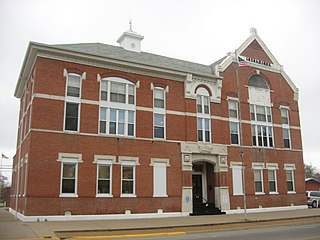
White County is a county located in the U.S. state of Illinois. According to the 2020 census, it had a population of 13,877. Its county seat is Carmi. It is located in the southern portion of Illinois known locally as "Little Egypt".

Gallatin County is a county located in the U.S. state of Illinois. According to the 2020 census, it has a population of 4,946, making it the third-least populous county in Illinois. Its county seat is Shawneetown. It is located in the southern portion of Illinois known locally as Little Egypt. Located at the mouth of the Wabash River, Gallatin County, along with neighboring Posey County, Indiana, and Union County, Kentucky form the tri-point of the Illinois-Indiana-Kentucky Tri-State Area.

Equality is a village in Gallatin County, Illinois, United States. The population was 539 at the 2020 census. Near the village are two points of interest, the Crenshaw House and the Garden of the Gods Wilderness. Equality was the county seat of Gallatin County from 1826–1851.

Old Shawneetown is a village in Gallatin County, Illinois, United States. As of the 2020 census, the village had a population of 113, down from 193 at the 2010 census. Located along the Ohio River, Shawneetown served as an important United States government administrative center for the Northwest Territory. The village was devastated by the Ohio River flood of 1937. The village's population was moved several miles inland to New Shawneetown.

Omaha is a village in Gallatin County, Illinois, United States. The population was 209 at the 2020 census.

Shawneetown is a city in Gallatin County, Illinois, United States. The population was 1,054 at the 2020 United States Census. It is the county seat of Gallatin County.

Harrisburg is a city in and the county seat of Saline County, Illinois, United States. It is located about 57 miles southwest of Evansville, Indiana, and 111 mi (179 km) southeast of St. Louis, Missouri. Its 2020 population was 8,219, and the surrounding Harrisburg Township had a population of 10,037, including the city residents. Harrisburg is included in the Illinois–Indiana–Kentucky tri-state area and is the principal city in the Harrisburg micropolitan statistical area with a combined population of 24,913.

The Saline River is a tributary of the Ohio River, approximately 27 miles (43 km) long, in the Southern Illinois region of the U.S. state of Illinois. The river drains a large section of southeast Illinois, with a drainage basin of 1,762 square miles (4,564 km2). The major tributaries include the South Fork, Middle Fork and North Fork, all lying within the Saline Valley. The once meandering swampy river was important among Native Americans and early settlers as a source of salt from numerous salt springs where it was commercially extracted in the early 19th century.

The Shawneetown Bank State Historic Site is an historic bank building in Old Shawneetown, Illinois, and is the oldest structure in Illinois built specifically as a bank. A Greek Revival structure built in 1839–1841 in what was then called Shawneetown, it was the home of a series of banks into the 20th century. The building is brick with a limestone front façade.

The Randolph County Courthouse is a government building in central Chester, the county seat of Randolph County, Illinois, United States. Built in 1972, it is the latest of several buildings to serve as the seat of government in Illinois' oldest county, and the second erected in Chester after the relocation of county government from Kaskaskia in 1847 after a devastating flood.

The Hardin County Courthouse is a government building in Elizabethtown, the county seat of Hardin County, Illinois, United States. Built in 1927, it is the fourth building to serve this purpose in Hardin County, following three that were replaced due to fires or fire-related concerns.

The Pulaski County Courthouse is a government building in Mound City, the county seat of Pulaski County, Illinois, United States. Built in 1912 and damaged by the Great Flood of 1937, it remains in use as the county's courthouse.
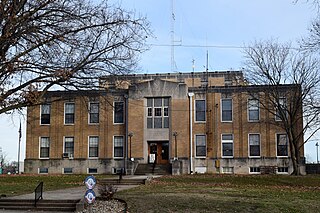
The Hamilton County Courthouse is a government building in McLeansboro, the county seat of Hamilton County, Illinois, United States. Built in 1938, more than forty years after the destruction of the previous courthouse in McLeansboro, it is the third such building to serve the county.

The Saline County Courthouse is a government building in Harrisburg, the county seat of Saline County, Illinois, United States. Built in 1967, it is the fifth courthouse to serve the county and the third in Harrisburg.

The Williamson County Courthouse is a government building in Marion, the county seat of Williamson County, Illinois, United States. Built in 1971, it is the fourth courthouse in Marion's history.

The fourth Franklin County Courthouse was a government building in central Benton, the county seat of Franklin County, Illinois, United States. Built in 1874 to replace an older structure that could no longer serve the county's needs, it was the fourth building to serve as a courthouse for Franklin County. Demolition of the building started on Aug. 5, 2020, and was completed within the month. A new courthouse, inaugurated on April 22, 2022, was built on the same location as the fourth Franklin County Courthouse.
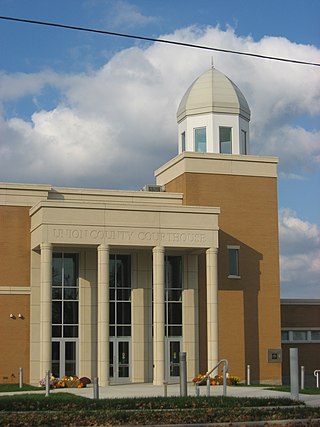
The Union County Courthouse is a government building in central Jonesboro, the county seat of Union County, Illinois, United States. Built in 2013, it replaced a brick structure whose core predated the Civil War.
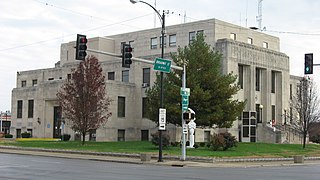
The Jefferson County Courthouse is a government building in Mount Vernon, the county seat of Jefferson County, Illinois, United States. Built in 1939 by the federal Works Progress Administration, it is the fifth courthouse to serve Jefferson County.

The Alexander County Courthouse is a government building in central Cairo, the county seat of Alexander County, Illinois, United States. Built in the 1960s, it is the latest in a series of courthouses erected in four towns across Alexander County.
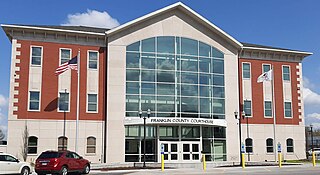
The Franklin County Courthouse is a government building located in Benton, Illinois. It took 620 days to complete from start to finish, costing around $13 million for the courthouse itself. A nearby government building also saw renovations so it could house the courtrooms and the Circuit Clerk's office while the courthouse was under construction. That brought the total cost to around $18 million.




















